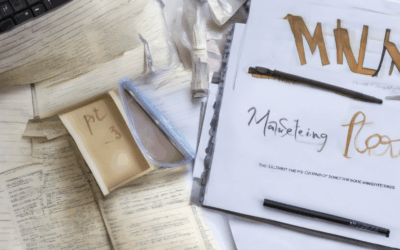Creating compelling narratives is a challenging task that often leaves writers feeling stuck, searching endlessly for unique storyline ideas. Whether you’re crafting a novel, short story, or even a personal narrative, the pressure to innovate can be overwhelming. However, with the right strategies and tools, anyone can unlock their creativity and generate stellar narrative ideas. From exploring diverse genres to leveraging real-life inspiration, this guide offers proven methods to spark your imagination and overcome writer’s block. By delving into the basics of narrative creation, discovering effective ways to develop creative ideas, and learning how to craft engaging plots and characters, you’ll gain the skills needed to produce stories that resonate with readers. Join us as we explore the art of storytelling, offering practical tips and insights to help you master the craft of creating memorable narratives.
Key Takeaways
- Understand the medium to tailor your storytelling effectively.
- Seek inspiration from diverse sources to spark fresh perspectives.
- Use brainstorming techniques like freewriting to generate ideas.
- Collaborate with others to enrich and refine your narrative concepts.
- Stay curious and explore new territories to evolve your storytelling.
- Practice consistently to build creativity and skill over time.
- Embrace failure as a learning opportunity for growth.
- Analyze successful stories to refine your own approach.
- Write from multiple perspectives to broaden your narrative depth.
- Keep a creative journal to track ideas and monitor progress.

How to Craft Creative Narrative Ideas
To unlock your creativity and develop unique narrative ideas, follow these organized steps:
- Define Your Purpose : Begin by clarifying the message or theme you wish to convey. Whether it’s adventure, love, or self-discovery, having a clear purpose guides your creative direction.
- Explore Themes : Look at popular stories to identify resonant themes, then infuse them with originality. Consider twisting familiar elements to create something fresh and distinctive.
- Develop Unique Characters : Create characters with unconventional traits. For instance, introduce a scientist as the protagonist rather than a traditional hero, adding a novel perspective to your story.
- Craft a Thoughtful Plot : Design a plot with unexpected twists. Instead of a conventional conflict, delve into complex antagonists with personal motivations to deepen engagement.
- Establish Writing Routine : Consistency is key. Dedicate specific times daily to writing and maintain a writer’s journal to track progress and reflect on improvements.
- Seek Inspiration : Draw from personal experiences and everyday observations. Keep a notebook of notable moments and consider collaborating with others for diverse perspectives.
- Practice Regularly and Revisewise : Write daily to build momentum and embrace revision to enhance your work based on feedback and reflection.
- Leverage Resources : Join writing groups, take courses, and use prompts to stimulate creativity. Explore various genres and styles to maintain innovation and avoid burnout.
- Find Your Voice : Experiment with different writing techniques to develop a unique style. Engage with the writing community for support and motivation.
By systematically applying these strategies, you can foster a dynamic creative process, leading to compelling and original narratives.
Effective Ways to Develop Creative Narrative Ideas
Developing creative narrative ideas requires a combination of inspiration, technique, and practice. Here are some proven strategies to unlock your creativity and craft compelling stories:
1. Understand Your Medium
Whether you’re writing a novel, screenplay, or graphic novel, understanding the medium is crucial. Each format has unique rules and storytelling conventions. Experiment with different structures and styles to find what works best for your vision.
2. Research and Inspiration
Look beyond your immediate field for inspiration. Read widely, explore different cultures, and study various disciplines like art, science, and philosophy. The cross-pollination of ideas often leads to fresh perspectives and innovative narratives.
3. Brainstorming Techniques
Start with freewriting or mind mapping to generate a flood of ideas. Use prompts to spark creativity, such as “What if the world was upside down?” or “How would a cat solve a mystery?” These exercises can unlock unexpected storylines.
4. Collaborate and Exchange Ideas
Work with fellow creators to bounce ideas off each other. Collaborative environments can lead to diverse and richer narratives. Share your drafts and seek feedback to refine your concepts and uncover blind spots.
5. Stay Curious and Evolve
Keep asking questions and explore unfamiliar territories. Attend workshops, watch documentaries, and engage with diverse communities. The more you learn, the more stories you can tell and the better they will be.
6. Practice Regularly
Creativity thrives on habit. Dedicate time each day to develop your craft. Write short scenes, experiment with dialogue, and revise your work. Consistency builds momentum and sharpens your storytelling skills.
7. Embrace Failure and Iterate
Not every idea will succeed, and that’s okay. Treat failed attempts as learning opportunities. Analyze what worked and what didn’t, then refine your approach. Iteration is key to growth as a storyteller.
8. Study Great Stories
Analyze successful narratives to understand their structure, themes, and emotional impact. Study authors like James Whitfield Thomson and others who masterfully craft compelling tales. Learn from their techniques and adapt them to your own style.
9. Explore Multiple Perspectives
Write from different points of view to broaden your horizons. Imagine how a character from another culture or background might perceive the world. This exercise can offer fresh insights and challenge your assumptions.
10. Keep a Creative Journal
Document your thoughts, observations, and ideas in a journal. Review it periodically to track your progress and identify patterns in your creativity. This practice helps clarify your vision and keeps your work organized.
By combining these strategies, you can develop a robust creative process that yields original and impactful narrative ideas. Remember, creativity is a muscle that grows with use. Keep experimenting, learning, and telling stories that matter.

Effective Ways to Develop Creative Narrative Ideas
Developing creative narrative ideas requires a combination of inspiration, technique, and practice. Here are some proven strategies to unlock your creativity and craft compelling stories:
1. Understand Your Medium
Whether you’re writing a novel, screenplay, or graphic novel, understanding the medium is crucial. Each format has unique rules and storytelling conventions. Experiment with different structures and styles to find what works best for your vision.
2. Research and Inspiration
Look beyond your immediate field for inspiration. Read widely, explore different cultures, and study various disciplines like art, science, and philosophy. The cross-pollination of ideas often leads to fresh perspectives and innovative narratives.
3. Brainstorming Techniques
Start with freewriting or mind mapping to generate a flood of ideas. Use prompts to spark creativity, such as “What if the world was upside down?” or “How would a cat solve a mystery?” These exercises can unlock unexpected storylines.
4. Collaborate and Exchange Ideas
Work with fellow creators to bounce ideas off each other. Collaborative environments can lead to diverse and richer narratives. Share your drafts and seek feedback to refine your concepts and uncover blind spots.
5. Stay Curious and Evolve
Keep asking questions and explore unfamiliar territories. Attend workshops, watch documentaries, and engage with diverse communities. The more you learn, the more stories you can tell and the better they will be.
6. Practice Regularly
Creativity thrives on habit. Dedicate time each day to develop your craft. Write short scenes, experiment with dialogue, and revise your work. Consistency builds momentum and sharpens your storytelling skills.
7. Embrace Failure and Iterate
Not every idea will succeed, and that’s okay. Treat failed attempts as learning opportunities. Analyze what worked and what didn’t, then refine your approach. Iteration is key to growth as a storyteller.
8. Study Great Stories
Analyze successful narratives to understand their structure, themes, and emotional impact. Study authors like James Whitfield Thomson and others who masterfully craft compelling tales. Learn from their techniques and adapt them to your own style.
9. Explore Multiple Perspectives
Write from different points of view to broaden your horizons. Imagine how a character from another culture or background might perceive the world. This exercise can offer fresh insights and challenge your assumptions.
10. Keep a Creative Journal
Document your thoughts, observations, and ideas in a journal. Review it periodically to track your progress and identify patterns in your creativity. This practice helps clarify your vision and keeps your work organized.
By combining these strategies, you can develop a robust creative process that yields original and impactful narrative ideas. Remember, creativity is a muscle that grows with use. Keep experimenting, learning, and telling stories that matter.

Effective Ways to Develop Creative Narrative Ideas
Developing creative narrative ideas requires a combination of inspiration, technique, and practice. Here are some proven strategies to unlock your creativity and craft compelling stories:
1. Understand Your Medium
Whether you’re writing a novel, screenplay, or graphic novel, understanding the medium is crucial. Each format has unique rules and storytelling conventions. Experiment with different structures and styles to find what works best for your vision.
2. Research and Inspiration
Look beyond your immediate field for inspiration. Read widely, explore different cultures, and study various disciplines like art, science, and philosophy. The cross-pollination of ideas often leads to fresh perspectives and innovative narratives.
3. Brainstorming Techniques
Start with freewriting or mind mapping to generate a flood of ideas. Use prompts to spark creativity, such as “What if the world was upside down?” or “How would a cat solve a mystery?” These exercises can unlock unexpected storylines.
4. Collaborate and Exchange Ideas
Work with fellow creators to bounce ideas off each other. Collaborative environments can lead to diverse and richer narratives. Share your drafts and seek feedback to refine your concepts and uncover blind spots.
5. Stay Curious and Evolve
Keep asking questions and explore unfamiliar territories. Attend workshops, watch documentaries, and engage with diverse communities. The more you learn, the more stories you can tell and the better they will be.
6. Practice Regularly
Creativity thrives on habit. Dedicate time each day to develop your craft. Write short scenes, experiment with dialogue, and revise your work. Consistency builds momentum and sharpens your storytelling skills.
7. Embrace Failure and Iterate
Not every idea will succeed, and that’s okay. Treat failed attempts as learning opportunities. Analyze what worked and what didn’t, then refine your approach. Iteration is key to growth as a storyteller.
8. Study Great Stories
Analyze successful narratives to understand their structure, themes, and emotional impact. Study authors like James Whitfield Thomson and others who masterfully craft compelling tales. Learn from their techniques and adapt them to your own style.
9. Explore Multiple Perspectives
Write from different points of view to broaden your horizons. Imagine how a character from another culture or background might perceive the world. This exercise can offer fresh insights and challenge your assumptions.
10. Keep a Creative Journal
Document your thoughts, observations, and ideas in a journal. Review it periodically to track your progress and identify patterns in your creativity. This practice helps clarify your vision and keeps your work organized.
By combining these strategies, you can develop a robust creative process that yields original and impactful narrative ideas. Remember, creativity is a muscle that grows with use. Keep experimenting, learning, and telling stories that matter.
Effective Ways to Develop Creative Narrative Ideas
Developing creative narrative ideas requires a combination of inspiration, technique, and practice. Here are some proven strategies to unlock your creativity and craft compelling stories:
1. Understand Your Medium
Whether you’re writing a novel, screenplay, or graphic novel, understanding the medium is crucial. Each format has unique rules and storytelling conventions. Experiment with different structures and styles to find what works best for your vision.
2. Research and Inspiration
Look beyond your immediate field for inspiration. Read widely, explore different cultures, and study various disciplines like art, science, and philosophy. The cross-pollination of ideas often leads to fresh perspectives and innovative narratives.
3. Brainstorming Techniques
Start with freewriting or mind mapping to generate a flood of ideas. Use prompts to spark creativity, such as “What if the world was upside down?” or “How would a cat solve a mystery?” These exercises can unlock unexpected storylines.
4. Collaborate and Exchange Ideas
Work with fellow creators to bounce ideas off each other. Collaborative environments can lead to diverse and richer narratives. Share your drafts and seek feedback to refine your concepts and uncover blind spots.
5. Stay Curious and Evolve
Keep asking questions and explore unfamiliar territories. Attend workshops, watch documentaries, and engage with diverse communities. The more you learn, the more stories you can tell and the better they will be.
6. Practice Regularly
Creativity thrives on habit. Dedicate time each day to develop your craft. Write short scenes, experiment with dialogue, and revise your work. Consistency builds momentum and sharpens your storytelling skills.
7. Embrace Failure and Iterate
Not every idea will succeed, and that’s okay. Treat failed attempts as learning opportunities. Analyze what worked and what didn’t, then refine your approach. Iteration is key to growth as a storyteller.
8. Study Great Stories
Analyze successful narratives to understand their structure, themes, and emotional impact. Study authors like James Whitfield Thomson and others who masterfully craft compelling tales. Learn from their techniques and adapt them to your own style.
9. Explore Multiple Perspectives
Write from different points of view to broaden your horizons. Imagine how a character from another culture or background might perceive the world. This exercise can offer fresh insights and challenge your assumptions.
10. Keep a Creative Journal
Document your thoughts, observations, and ideas in a journal. Review it periodically to track your progress and identify patterns in your creativity. This practice helps clarify your vision and keeps your work organized.
By combining these strategies, you can develop a robust creative process that yields original and impactful narrative ideas. Remember, creativity is a muscle that grows with use. Keep experimenting, learning, and telling stories that matter.

Effective Ways to Develop Creative Narrative Ideas
Creating compelling narratives requires a blend of imagination, research, and strategic planning. Here are some proven approaches to spark creativity and develop unique story ideas:
- Explore Diverse Themes and Settings
- Research global cultures, historical periods, and lesser-known locations to find unique angles for your stories.
- Consider unconventional perspectives, such as exploring the lives of marginalized characters or imagining futuristic worlds.
- Develop Complex Characters
- Create multi-dimensional protagonists with distinct personalities, motivations, and flaws.
- Give your characters meaningful backstories that tie into the overall plot and themes.
- Experiment with Story Structures
- Try non-linear storytelling to add complexity and intrigue.
- Use flashbacks, foreshadowing, and multiple plot threads to keep readers engaged.
- Leverage Research and Inspiration
- Read widely across genres and styles to absorb different writing techniques.
- Study real-life events, historical figures, and cultural movements for story inspiration.
- Collaborate and Brainstorm
- Work with writing partners to challenge your perspectives and generate new ideas.
- Participate in writing groups or workshops to gain feedback and explore diverse viewpoints.
- Stay Curious and Open-Minded
- Ask questions and explore unknowns to uncover hidden story potential.
- Be open to unexpected twists and willing to take creative risks.
By combining these strategies, you can unlock your creativity and craft narratives that resonate deeply with readers. Remember, the key is to stay curious, explore the unfamiliar, and continually evolve your approach to storytelling.





0 Comments